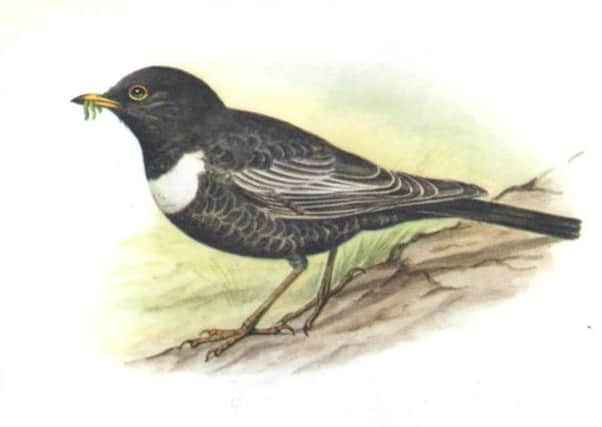Scottish research needed to save endangered bird


Scotland is home to two thirds of the UK’s ring ouzels, popularly known as mountain blackbirds, but numbers have dropped by a massive 36 per cent in the past 15 years.
Conservationists are now setting out to improve breeding grounds in an attempt to stop the bird disappearing from the rocky hillsides and gullies in the highest parts of the country.
Advertisement
Hide AdAdvertisement
Hide AdResearchers from the nature charity RSPB Scotland have uncovered new evidence that shows a lack of suitable habitat is the key threat to survival of the species in this country.
The ring ouzel was added to the highest priority red list of Birds for Conservation Concern in 1999, when a count estimated the Scottish population at 5,503 breeding pairs. The most recent national survey, carried out in 2012 by Scottish Natural Heritage, RSPB, Natural England and Natural Resources Wales, showed numbers had fallen by more than a third to just 3,520 pairs. Throughout the UK, breeding pairs of the threatened bird have fallen by nearly 30 per cent, from 7,549 to 5,332, over the same period.
Now, as the elusive bird returns to the Scottish uplands to breed after wintering in the mountains of North Africa, a long-running project in Glen Clunie, Aberdeenshire, has shone new light on the mystery of their disappearance and offers fresh hope for giving them a home.
A new three-year project is being launched to create ideal habitats at breeding grounds, which experts hope will help to attract the birds by providing safe nesting sites and plentiful food supplies, as well as offering young birds protection from predators.
In decline
Experts say the population has likely been in decline for more than a century, but the most recent figures show numbers are dropping at an alarming rate.
The results of intensive research suggest the drop in ring ouzel numbers is mainly down to an increasingly poor survival rate for young birds. It is thought chicks are struggling to make it through their first year of life because of a scarcity of suitable habitat.
“The widespread disappearance of this stunning mountain bird is deeply worrying,” said RSPB Scotland scientist Innes Sim, who has been studying the ring ouzel since 1998.
“Through our long-term studies in Glen Clunie we have identified that improving first-year survival may be the key to stabilising, and eventually reversing, the population decline.
Advertisement
Hide AdAdvertisement
Hide Ad“Over the next three years we will be attempting to improve conditions for ring ouzels by providing the mix of habitats that we have identified as being important for successful breeding and the survival of recently fledged young.”
Foraging
Ring ouzels, which are easily recognised by their black plumage and distinctive white breast band, are known to forage for creatures such as worms and beetles in short grass. They also feed on a mix of grass and heather early in the summer, later switching their diet to blaeberries and rowan berries.
To thrive they need access to deeper vegetation, such as heather, which helps conceal their nests and newly fledged young.
They arrive in Scotland in March and April to breed in steep-sided valleys, crags and gullies, before taking wing again in September to migrate south for winter.
SEE ALSO: